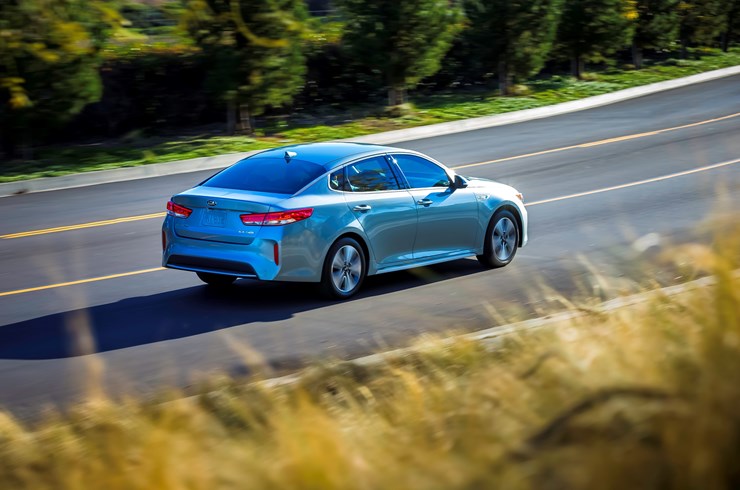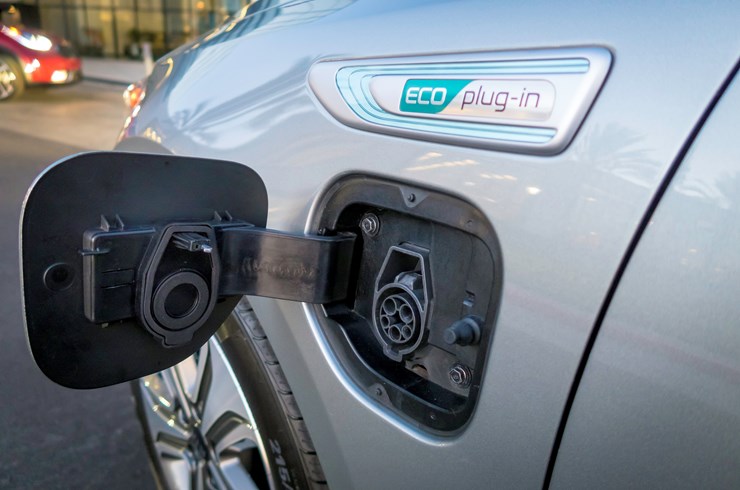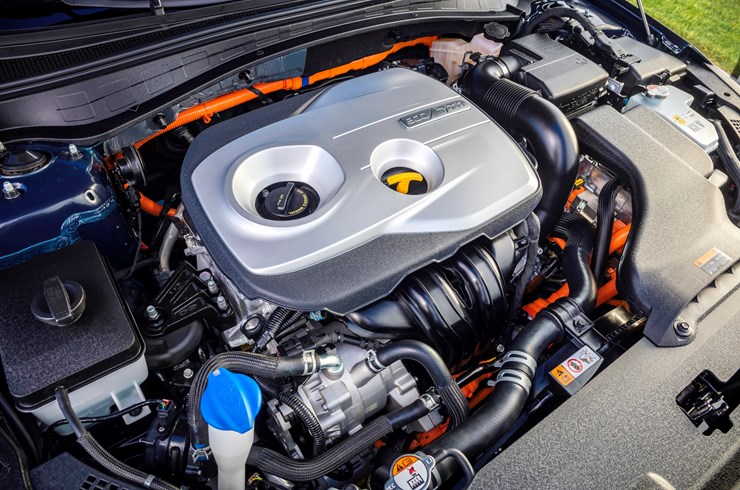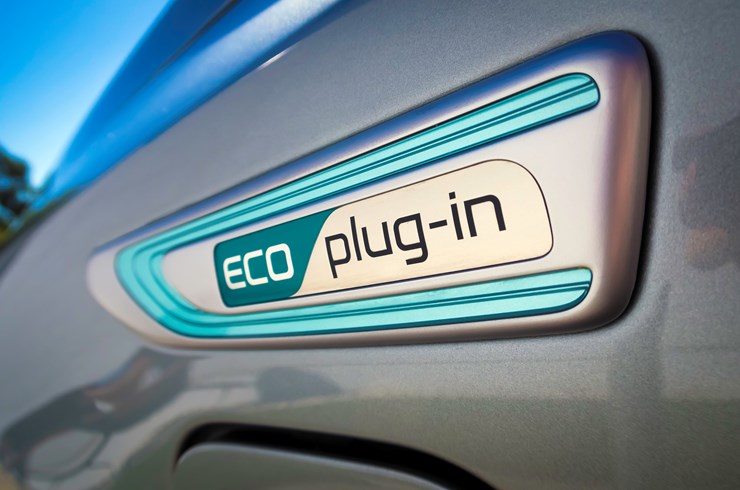When You’re Not Quite Ready For A Battery Electric Car
Surveys show that more and more American drivers are considering battery electric vehicles (BEVs) but are still hesitant in making the purchase. There are several reasons, one of which is still “range anxiety.” That’s the fear of depleting the battery’s electricity, leaving one stranded in the middle of who knows where.
If you like the idea of an electric vehicle but are holding back, you should consider a plug-in electric hybrid (PHEV). It’s two cars in one; a short range electric vehicle and a hybrid vehicle. That means when the battery is depleted a gasoline engine automatically takes over and operates as a standard gasoline-powered hybrid. Thus, range anxiety is no longer an issue.
Yes, like an electric car the battery needs to be recharged, either from a standard electric outlet or home charger or, from a public charging station. If the battery is no longer delivering electrons, just keep on driving and fill the gas tank until you can recharge.
2018 Kia Optima PHEV
The Kia Optima plug-in was introduced for the 2017 model year. For 2018 there are no major changes; just paint and trim colors.

Like last year, the 2018 Kia Optima PHEV is thousands of dollars less than other similar models in the segment including the Ford Fusion Energi. Although only one trim level exists for the car, the EX trim, it’s at a level that most buyers will be looking for.
When combining the plug-in Optima’s electric driving range with the hybrid range, the car can travel up to 610 miles. On just electric power alone, it can go as far as 29 miles before needing a recharge. On gas-powered performance, it’s EPA rated at 40-mpg combined city and highway, while its electric power economy is 103 MPGe (Miles Per Gallon equivalent). That alone is a good enough reason to check the car out and take a test drive.
As a plug-in hybrid, the 2018 Kia Optima PHEV has two power sources: a 2.0-liter gasoline-powered engine with 154 horsepower and a 66 horsepower electric motor. Under acceleration, the engine and electric motor pool their resources to provide a combined system output of 220 horsepower. That puts it right in line with traditional gas-powered vehicles in its segment.
What distinguishes the Optima plug-in from other PHEVs is its six-speed automatic transmission, a relative anomaly some drivers will prefer over a continuously variable transmission (CVT) more common to hybrids. While other carmakers have gone so far as to simulate stepped gearing in their continuously variable automatic transmissions, Kia offers the real thing, making the vehicle feel much like a conventional gas-powered car.
Exterior and Interior
When Kia redesigned the Optima in 2016 they took a step back from the forward-looking, forward-thinking example of daring and aggressive design of the previous version. The look is conservative and mature. With the Optima PHEV, the automaker put form in the service of function — better aerodynamics that matches the Tesla Model S electric sedan’s drag coefficient of just 0.24 Cd.
From the outside, the plug-in Optima’s shapely hood, elongated dimensions, sloping roofline, and curves hint at a sportier mission. The car has Kia’s recognizable sporty honeycombed front grille along with chrome-accented exterior trim.

Inside, the conservatively laid out driver’s quarters features simply arranged buttons and knobs, and occupant space front and back that is roomy and comfortable. However, the sloping roofline cuts into rear head space, but wide door openings help taller passengers enter and exit without much fuss. There’s just enough head room for six-footers, but taller passengers may want to consider calling shotgun—or taking the keys altogether.
I gave the plug-in Optima a big demerit for cargo capacity. There is less cargo space in the trunk than on most compact hatchbacks — just 9.89 cubic feet. If it’s meant to be a family car, it’s for one that doesn’t need to carry any baby stuff beyond a diaper bag.

Specification levels are high with the single EX trim level. Offerings include cruise control, heated and power-folding exterior mirrors, heated steering wheel and leather seats with heating for the front row and 10-way power adjustment for the driver.
The 2018 Optima Plug-in Hybrid continues Kia’s knack for creating strong showroom appeal by including hot-button features as standard. These include Kia’s UVO’s infotainment telematics system with an eight inch display screen. It includes Apple CarPlay and Android Auto, as well as Bluetooth hands-free mobile phone linking, satellite radio and a rear-camera display. Add to the list an auxiliary audio jack and a USB interface for iPods and other digital media, plus a tilt/telescoping steering wheel fitted with audio, Bluetooth, and cruise controls. A bonus is the standard Harman Kardon 10-speaker audio system.
For those who want the latest in comprehensive safety tech, there’s the Optional Technology Package. It adds autonomous emergency braking, adaptive cruise control, blind spot detection, rear cross-traffic alert, forward collision mitigation, rear park assist, LED headlights with dynamic bending light, panoramic sunroof and LED interior lighting. You also get ventilated front seats, a 10-way power front passenger seat and heated rear seats.
On the Road
Driving the 2018 Optima Plug-in Hybrid is a soothing respite to the bustle and hubbub of city traffic — nicely soundproofed, luxuriously appointed and pleasant to drive. Kia’s reason for choosing an automatic transmission rather than the more common hybrid continuously variable transmission (CVT) was to address the complaint that hybrids were boring to drive.

Mash the throttle and the six-speed transmission winds nicely toward top rpm, shifting each time somewhere around 6,000 rpm, when the full tug of torque seems ready to run out. So it would seem that Kia’s goal of achieving a driving experience that closely parallels a conventional car is accomplished.
As for handling, the car has balanced agility for the hybrid sedan class and the suspension keeps everything secure. The ride is composed and comfortable with the suspension soaking up potholes and rough pavement.
My favorite aspect of the Kia’s road manners is its responsive steering. It has a quick and precise feeling, is balanced and firm, but never twitchy. Regenerative and hydraulic braking play a role in the electric hybrid system and the brake pedal felt firm and easily hauled down speed.
Accelerating moderately and keeping pace with 70-75 mph freeway traffic, after diving 236 miles in our EX test car nearly equally between city and highway driving we averaged 42.8 mpg. What likely helped beat the EPA rating was the hybrid system’s ability to travel on electric power at 70 mph, something I found fairly easy to do.
In the Marketplace
The 2018 Kia Optima Plug-in Hybrid faces off against several mid-size sedan competitors. These include Kia’s sister company’s Hyundai Sonata PHEV, Toyota’s Prius Prime, the Ford Fusion Energi, Honda Clarity PHEV and Chevrolet’s outgoing Volt.
At $35,210, the 2018 Kia Optima Plug-in Hybrid is priced competitively. Hyundai’s Sonata PHEV is priced from $33,250 to $38,850, while the Prius Prime prices range from $27,300 to $33,300. Ford offers three trim levels for the Fusion Energi with a price starting at $33,400 to $41,400.
Honda’s Clarity PHEV comes in two flavors, Base and Touring, with a sticker price of $33,000 for the base trim and $36,600 for the Touring. Chevrolet is ceasing producion of the Volt next February, so expect closeout prices soon. In the meantime the Volt has a price of $33,220 for the LT trim and $35,570 for the Premier trim.

Each of the above PHEVs have different electric-only driving ranges as well as different hybrid-only driving ranges as well as different standard and optional features. So, it’s important to check out the details.
But the 2018 Optima Plug-in Hybrid offers a compelling reason to buy — Kia’s warranty. Basic coverage is five-years/60,000-miles bumper-to-bumper, and 10-years/100,000-miles for the hybrid powertrain, which includes the battery pack, electric motor, gear drive unit, electric power control unit, onboard charger, the works.
Then there’s the warranty knockout punch—a lifetime warranty for the battery pack. If the lithium polymer battery fails, Kia will replace the battery and cover recycling costs of the old battery pack free of charge to the original owner.
That’s impressive and reassuring. If for no other reason than the warranty, if you have decided it’s time to move to a plug-in hybrid, the 2018 Kia Optima PHEV should be on your shopping list.
Make sure to opt-in to the Clean Fleet Report newsletter (top right of page) to be notified of all new stories and vehicle reviews.”
Related Stories You Might Enjoy—the PHEV Challengers
News: 2019 Ford Fusion Energi Gets More Range
News: 2018 Hyundai Sonata PHEV Gets Price Cut, More Range
Road Test: 2017 Hyundai Sonata PHEV
Flash Drive: 2018 Toyota Prius Prime
Road Test: 2017 Ford Fusion Energi
Road Test: 2018 Honda Clarity PHEV
Road Test: 2019 Chevrolet Volt.
Disclosure:
Clean Fleet Report is loaned free test vehicles from automakers to evaluate, typically for a week at a time. Our road tests are based on this one-week drive of a new vehicle. Because of this we don’t address issues such as long-term reliability or total cost of ownership. In addition, we are often invited to manufacturer events highlighting new vehicles or technology. As part of these events we may be offered free transportation, lodging or meals. We do our best to present our unvarnished evaluations of vehicles and news irrespective of these inducements.
Our focus is on vehicles that offer the best fuel economy in their class, which leads us to emphasize electric cars, plug-in hybrids, hybrids and diesels. We also feature those efficient gas-powered vehicles that are among the top mpg vehicles in their class. In addition, we aim to offer reviews and news on advanced technology and the alternative fuel vehicle market. We welcome any feedback from vehicle owners and are dedicated to providing a forum for alternative viewpoints. Please let us know your views at publisher@cleanfleetreport.com.

6 thoughts on “Road Test: 2018 Kia Optima PHEV (Plug-in Hybrid)”